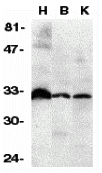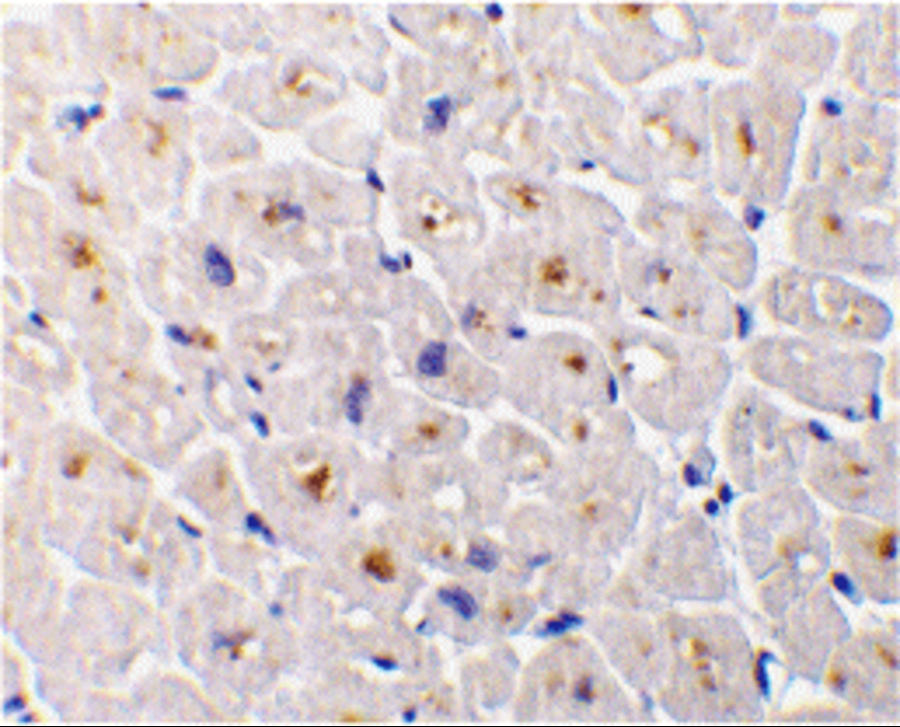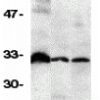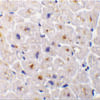Anti-DcR3 (NT) Antibody (2140)
$445.00
| Host | Quantity | Applications | Species Reactivity | Data Sheet | |
|---|---|---|---|---|---|
| Rabbit | 100ug | ELISA,WB,IHC-P | Human, Mouse, Rat |  |
SKU: 2140
Categories: Antibody Products, Apoptosis Antibodies, Products
Overview
Product Name Anti-DcR3 (NT) Antibody (2140)
Description Anti-DcR3 (NT) Rabbit Polyclonal Antibody
Target DcR3 (NT)
Species Reactivity Human, Mouse, Rat
Applications ELISA,WB,IHC-P
Host Rabbit
Clonality Polyclonal
Isotype IgG
Immunogen Peptide corresponding to aa 31-46 of human DcR3 precursor (accession no. AF104419).
Properties
Form Liquid
Concentration Lot Specific
Formulation PBS, pH 7.4.
Buffer Formulation Phosphate Buffered Saline
Buffer pH pH 7.4
Format Purified
Purification Purified by peptide immuno-affinity chromatography
Specificity Information
Specificity This antibody recognizes human, mouse, and rat DcR3 (33kDa).
Target Name Tumor necrosis factor receptor superfamily member 6B
Target ID DcR3 (NT)
Uniprot ID O95407
Alternative Names Decoy receptor 3, DcR3, Decoy receptor for Fas ligand, M68
Gene Name TNFRSF6B
Gene ID 8771
Accession Number NP_003814
Sequence Location Secreted.
Biological Function DPubMed:21300286}.
Research Areas Apoptosis
Background Several novel members in the TNF receptor family, including DR3, DR4, DR5 and DR6, function as cell death receptors. Two decoy receptors, DcR1 and DcR2, compete with DR4 and DR5 for binding of their ligand, TRAIL. Another decoy receptor, DcR3/TR6 was discovered recently. Unlike DcR1 and DcR2, DcR3 is a soluble rather than a membrane- associated molecule. DcR3 binds to FasL and LIGHT and inhibits FasL- and LIGHT-induced apoptosis. DcR3 transcript is expressed in some lung and colon carcinomas and in some normal tissues.
Application Images



Description Western blot analysis of DcR3 in human heart (H), brain (B), and kidney (K) tissue lysates with DcR3 antibody at 1:500 dilution.

Description Immunohistochemistry of DcR3 in human heart tissue with DcR3 antibody at 1 ug/mL.
Handling
Storage This antibody is stable for at least one (1) year at -20°C. Avoid multiple freeze-thaw cycles.
Dilution Instructions Dilute in PBS or medium which is identical to that used in the assay system.
Application Instructions Immunoblotting: use at 1ug/mL.
These are recommended concentrations.
Enduser should determine optimal concentrations for their applications.
Positive control: Human heart tissue lysate.
These are recommended concentrations.
Enduser should determine optimal concentrations for their applications.
Positive control: Human heart tissue lysate.
References & Data Sheet
Data Sheet  Download PDF Data Sheet
Download PDF Data Sheet
 Download PDF Data Sheet
Download PDF Data Sheet




